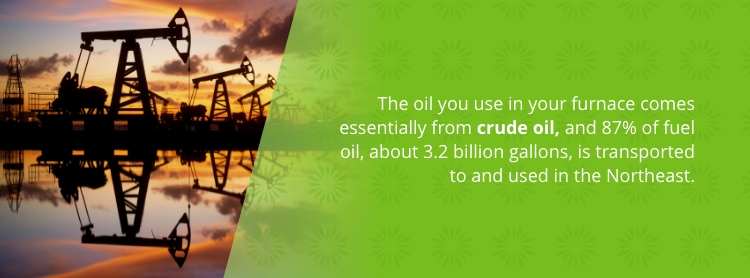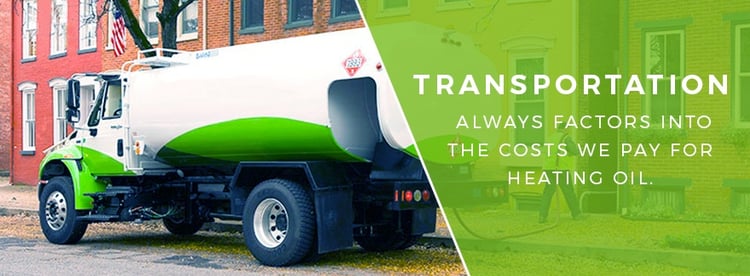Winter may technically be three months on the calendar, but everyone knows the chilly or freezing weather often lasts longer than that.
- How Do I Calculate My Heating Oil Costs Per Month? Know Gallons & History Averages
- How Much Heating Oil Will I Use During Winter?
- Average Heating Bill Cost
- How Long Will My Heating Oil Last?
- How Much Heating Oil Do I Use Based On Temperature?
- More Helpful Information on Fuel Oil Costs and Usage
- Are There Different Kinds of Heating-Fuel Oil?
- How Does an Oil-Burner Work?
- Analyze Weather
- Go on Burner Watch
- Isn't Cost Linked to Simple Supply and Demand?
- What Else Can I Do to Lower My Heating Oil Costs?
- What Difference Does the Tank Make?
- We Make Buying Fuel Oil Easy
Anyone with a fuel oil system faces the challenge of making sure there is always fuel in the tank no matter what Mother Nature brings. Along with these moving targets, prices vary with supply and demand. It is not unusual to become frustrated as we try to accurately answer the questions:
- How much heating oil will I use?
- How much heating oil should I use?
In this case, you can convert knowledge into power. The more you learn about fuel oil, the utilities that burn it, and how to estimate usage, the more accurately you will be able to estimate your oil needs. Below, we outline how to calculate usage!
How Do I Calculate My Heating Oil Costs Per Month? Know Gallons & History Averages

One way to get a general idea of how much heating oil you use is to know how many gallons your burner uses based on historical averages. Determining these benchmarks enables you to make the calculations that determine your personal average heating-oil consumption as well as monthly and yearly costs. Here are a few tips to help you calculate:
- Look for the manufacturer’s plate on your burner - this number gives capacity specifications in gallons per hour. The information might also be on the burner nozzle.
- An average oil-burning furnace uses somewhere between 0.8 and 1.7 gallons per hour while in operation. Find out where yours stands and if it performs to specification. Depending on their age and design, some models will use more or less than the average.
- Gather your heating-oil bills for as many months or years as you can - look at the quantities used. If you add together 12 months’ worth of usage and divide by 12, the product will be your average heating oil cost per month. You can get the annual average by adding together several years’ worth of gallons, then dividing that total by the number of years you have on hand to examine.
You can also estimate how much heating oil you'll use throughout the season with the help of a few formulas. To calculate your expected consumption, you first need to know how many degree days you can expect to go through in your location. A degree day is a 1-degree difference between the outside temperature and 65 degrees Fahrenheit, the indoor threshold at which the heater is likely to engage in most homes.
Determine degree days for your area by learning what its average temperature is during a 24-hour period in the winter months. Then, subtract this number from 65. For example, if you get an average temperature of 35 over the period of a day, take 65 − 35 to get an answer of 30 heating degree days. If this temperature is maintained for three days, multiply 30 x 3 to get 90 degree days for that three-day period.
Next, you'll need to determine your home's K-factor. To get the K-factor, divide the number of degree days since your last delivery, factor Y, by how many gallons of heating oil come in a delivery, factor Z. The formula for this looks like:
- Y / Z = K-factor
Let's say that on October 1, the unofficial beginning of the heating season, you get a 200-gallon delivery of heating oil. By February 1, the "end" of the season, you've depleted your supply and need another 200-gallon delivery. Throughout the winter, you kept track of heating degree days and determined that there were 2,000 during this time. Your K-factor formula would be as follows:
- 2,000 / 200 = 10
With this information, you can clearly see that you'll need a new fuel delivery every 2,000 degree days. During milder winters, this fuel might last you longer than a year with a harsh season.
Figuring out how to calculate heating-oil consumption requires analysis, but it will help to establish one or several baseline points so you know your household-specific averages.
How Much Heating Oil Will I Use During Winter?
With the winter months on the horizon, efficiently heating your home is an essential. If you use oil to heat your home, you'll have to think about how much it will cost, how long it will last, and how much you may actually use. Here's how to make your calculations and estimations in the safest and most accurate possible way.
Average Heating Bill Cost
When you pay for oil to heat your home, it's important for you to know what an average cost might be. But how can you determine this cost when average costs vary so greatly depending on your location and the time of year? The U.S. Energy Information Administration (EIA) offers a monthly breakdown of heating oil prices, showing average dollars per gallon spent each month from 1990-2019. From this chart, you'll see that during the winter months of 2019, the national average was just over $3.00 per gallon.
How Long Will My Heating Oil Last?
So how long will a full tank of oil last? A number of factors are involved, such as the size of your home, the size of your oil tank, and outside temperatures. But assuming an average oil tank holds about 275 gallons, here are some steps you can take to figure out how long your oil might last:

- Determine how many gallons it took to refill your tank, and divide that number by the number of days it took for the tank to be refilled. For example, if it took 200 gallons to fill your oil tank after 20 days, you would be using approximately 10 gallons a day.
- Monitor outside temperatures to see how they affect your oil usage.
According to the U.S. EIA, approximately 5.7 million households in the U.S. use heating oil as their main heating fuel, with 85% of these households in the Northeast census region.
If you live in an area that experiences a significant degree of temperature variation, that fluctuation will be important to take into account as you calculate how long your oil might last. For instance, the average high temperature for Massachusetts in January is 36 degrees Fahrenheit, while the average low is 22 degrees, so you shouldn't be surprised to find variation not only month to month but also year to year.
How Much Heating Oil Do I Use Based on Temperatures?
You have an idea of how long your oil might last and how much it might cost, so how do you determine how much oil you should use based on temperature? Part of the answer to this question depends on your personal preference in terms of temperature and expense, but you can chart the temperatures as well as your oil expenditure over the course of a season to find out how much you use, on average, during the coldest days and how much you use when the temperatures are higher. That way, you'll gain an idea of what you can expect just by checking the thermostat.
Other factors will affect the amount of oil you use throughout the cold months as well. For example, your numbers will change based on the size of your home. You'll use more gallons to reach the ideal temperature in a bigger home and fewer for a smaller home.
Smart Touch Energy can handle all of your heating oil needs, and we know the importance of making the most of your supply. We provide maintenance, inspections, repair, oil delivery, tests, emergency service, lubrication, bleed-seal service, cleaning, and a range of energy solutions. Check pricing in your area today!
More Helpful Information on Fuel Oil Costs and Usage
In this next section, we provide additional information about understanding price changes, usage variables, as well as actions you can take to save more money!
The oil you use in your furnace comes essentially from crude oil, and 87% of fuel oil, about 3.2 billion gallons, is transported to and used in the Northeast. Oil comes from foreign and domestic sources including Canada, the Virgin Islands, and Venezuela and normally travels by truck, train, pipeline, and barge.
Oil companies usually refine crude using four main processes:
- Fractional distillation, a process of heating the oil to capture and compress the vapor
- Conversion of the fractions by chemical processing
- Treatment to remove impurities
- Combining the various fractions to make different products
The end products include gasoline, diesel fuel, heating oil, jet fuel, kerosene, and lubricating oil. You might wonder why heating oil has that red color to it, and the reason circles back to taxation. The Internal Revenue Service mandates the color so that heating oil, which is exempt from road-use tax, is distinguished from road-vehicle oil, which is subject to road-use tax.
Are There Different Kinds of Heating-Fuel Oil?
There are different blends and additives some companies add to produce a cleaner-burning fuel, but it’s all made from the same, basic, refined crude-oil product. You might hear of such products as bio-diesel or blends with supplements such as animal fat and oils, as well as oils from vegetables including soybean and corn.
People can consult with a trusted energy expert to talk about the detailed aspects of different blends and how one could fit a situation or need they have. In general, the industry has worked toward reducing the sulfur content of heating oil to make it more clean burning than it has ever been.
How Does an Oil-Burner Work?
If you have an oil-fueled furnace, the unit is connected to a tank that feeds the oil to the furnace, where typically a pump mixes it with air and forces it through a nozzle that turns the oil into a fine mist. The mist then gets injected into the combustion chamber, where it catches fire to heat either air or water depending on the type of system you have.
If you have a forced-air system, the unit pushes warm air through ducts and out through vents to heat your home. If you have a water-based system, it works either by producing steam or boiling water that travels through pipes to emit heat through your radiators or sometimes baseboards.
The system also has an emissions pipe to dispose of the waste produced during combustion of the fuel. The emissions usually travel through a flue, rise and escape through a chimney.
Analyze Weather
We all know how dramatically weather can affect our energy costs, so the more you know about yours; the better you can predict your own heating-oil needs. It might be 50 degrees in Maryland at the same time Maine has 10-degree weather, so specific information pertinent to your area will be most helpful.

The heating industry generally considers a “heating-degree day” as one with an outdoor temperature lower than about 60 degrees. You and your family might have a little bit of a different preference, but it is good to know at least the rough number of days per year you are likely to run the heat.
The Farmer’s Almanac or a quality weather forecasting company keeps statistics about weather over time that can be useful to you in estimating your heating-oil consumption. These and other sources also share information about unusual patterns such as polar vortices, El Niño/La Niña years and other phenomena that affect local weather.
As you look at this big-picture view, you will see the times when the cold typically comes and goes each year and the basic length of season, as well as any patterns or spikes. It might be relevant to know there has been a January cold blast for several years in a row or consistently mild periods during a certain time.
Weather examination will also reveal the worst extremes for which you might need to prepare. Some winters stand out in our mind as exceptionally cold, snowy, or long, but that is a much different perspective than knowing the hard numbers on how many days temperatures fall to heating temperature and by how much.
Go on Burner Watch
You can work in all kinds of useful calculations if you assess the burner. First, designate an hour when you can observe the burner’s operation closely, once during peak hours when it is coldest and again during the day’s warmest hours.
Usually, the coldest time is 3-6 a.m. and the warmest time is around 3 p.m., and you want to do both observation hours on the same day. When the burner engages and the system is in operation, start timing it to see how many minutes during the hour it burns fuel. Each time it starts, time it until it stops and then write down the minutes.
When finished with both hours, add all the minutes together and divide the sum by two to get the average. Multiply the average by 24 to reveal the average number of minutes per day your burner is operating and using fuel. From there, divide by 60 to determine the number of hours per day the furnace runs.
Once you know the hours per day, you can multiply them by the number of gallons per hour the manufacturer’s plate says the furnace uses. That will give you a close estimate of what your furnace uses per day.
Armed with usage-per-day data, you can check your tank capacity and then calculate how long your whole, half or quarter tank will last. Finally, you figure approximately how much oil you will need for the year by multiplying the usage-per-day number by the number of days you expect to run the heat.
Isn't Cost Linked to Simple Supply and Demand?
A consumer’s logical perspective on heating oil tends to be that if we are out, we can easily make more. That is true, but refineries usually “fire up” to make a number of different petroleum products at once and even high demand for one of them at a certain time does not always justify overall production expense.
Location and number of suppliers in the area can also affect the price you pay. If there is only one within many miles, you are likely to pay more than in a location where a handful of them do business within the same region and create competition. Dealers also affect the costs to a certain extent since they too must estimate need and make decisions on how much to have on hand through a given winter.

Transportation always factors into the costs we pay for heating oil, too. Any oil we use travels varying distances to reach us, and the farther it has to go, the more it is likely to cost. For example, a household in a rural location far from the supply base is likely to pay a bit more.
As you probably know by national news and experiences with other petroleum products, it simply is difficult to predict long-term demand because of the many factors that affect usage and price.
Quite a few variables affect your heating-oil use and cost:
- Thermostat settings make a big difference in the rate at which your furnace burns fuel.
- Strong wind can cause your home to sustain heat loss faster than when there is no wind.
- A building with good insulation can still be drafty, which affects how much heat is needed and therefore how much heating oil is used.
- How many heating-degree days you have affects operations — again, the number of days with an outdoor temperature lower than about 60 degrees.
- Insulation prevents warm air from escaping through your walls, roof, doorways and other areas, so naturally a lack of it makes your furnace work harder to heat the space.
- Oil-burner nozzle size might vary from two gallons an hour for an older furnace and in newer, more efficient models, about 0.65 gallons per hour.
- Frequency of cleaning, adjustment and other maintenance affect oil usage, supply cost, and furnace operation.
Check with your dealer: Quality energy companies have more sophisticated methods of usage estimation that take into account such factors as weather, where your thermostat is usually set, past usage and many others.
A reputable energy company will share insights about how to accurately estimate your needs. When or once you become a customer, they also have accurate current and historic data on your usage.
What Else Can I Do to Lower My Heating Oil Costs?
Scheduled delivery of your heating oil can eliminate a lot of headaches, math and research for you because your dealer then worries about when to come, how much you’re using and what’s happening in the market. Some people also fill the tank in late summer or early fall when prices are a bit lower.
The U.S. Energy Information Administration publishes many helpful resources, including a monthly newsletter that includes projections for residential heating-fuel prices from October through March. The Short-Term Energy Outlook also includes household-energy consumption and expenditure averages.
One of the most effective things you can do yourself to reduce heating-oil costs is to go on an energy-efficiency mission around your house:
- Beef up the attic and wall insulation.
- Caulk around the doors and windows.
- Seal door thresholds.
- Wrap inefficient windows with heat-activated plastic.
- Test for drafts and then seal any you find.
- Replace aged weather stripping.
- Open drapes and blinds for solar heat.
- Close closet doors and any vents to the outside like the fireplace and kitchen.
- Turn down the thermostat at night and when you’re gone.
- Install a programmable thermostat to automatically adjust the inside temperatures to your preference, an investment that pays for itself within about a year.
- Consider replacing any furnace, oil burner, nozzles or other parts of the system that are approaching or are more than 20 years old. Newer models can improve efficiency enough for you to save 15-25% on your heating-oil bill.

One former energy professional said a thorough cleaning and good tuning improved one older oil-burner furnace from a burning-efficiency rate of 68% to 78%. The efficiency rate gets better from there because, for example, a newer high-performance unit could possibly achieve 95% operational efficiency.
What Difference Does the Tank Make?
A typical residential heating-oil storage tank is made of steel, has a capacity of 275 gallons and is located above the ground, outside or in the basement. There are bigger sizes that might net you a volume discount, but the larger ones tend to be located underground.
If you are faced with replacing an old one or installing a brand-new heating-oil tank, be sure to check your state and local regulations regarding storage tanks. In general, smaller ones above the ground carry fewer regulatory requirements than the bigger, buried ones.
We Make Buying Fuel Oil Easy
Do not hesitate to contact Smart Touch Energy for any of your heating-oil and oil-burner furnace systems. We offer inspections, maintenance, repair, oil delivery, emergency service, tests, cleaning, lubrication, bleed-seal service and a range of energy solutions.
Our expertise can help you solve problems, make improvements, achieve better efficiency and get service and delivery to make sure the system stays in good shape to keep you warm and comfortable all winter. Smart Touch puts energy at your fingertips and brings a company culture based on innovation, responsiveness and commitment to customers. We can help with many of the things that are essential to your comfort and to a safe, well-maintained home.





